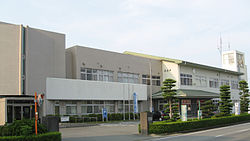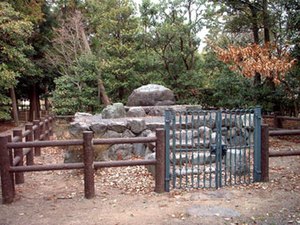Meiwa, Mie
Meiwa
明和町 | |
|---|---|
Town | |
 Meiwa town hall | |
 Location of Meiwa in Mie Prefecture | |
| Country | Japan |
| Region | Kansai |
| Prefecture | Mie Prefecture |
| District | Taki |
| Government | |
| • - Mayor | Yukimitsu Nakai |
| Area | |
• Total | 40.92 km2 (15.80 sq mi) |
| Population (September 2012) | |
• Total | 22,726 |
| • Density | 555/km2 (1,440/sq mi) |
| Time zone | UTC+9 (Japan Standard Time) |
| - Tree | Inumaki |
| - Flower | Iris |
| Phone number | 0596-52-7111 |
| Address | 945 Daigaku-Umanoue, Meiwa-chō, Taki-gun, Mie-ken 515-0332 |
| Website | www |

Meiwa (明和町, Meiwa-chō) is a town located in Mie Prefecture, Japan. As of September 2012, the town had an estimated population of 22,726 and a population density of 555 persons per km². The total area was 40.92 km².
Geography
Meiwa is located in eastern Kii Peninsula in central Mie Prefecture, bordering Ise Bay on the Pacific Ocean.
Adjacent municipalities
- The city of Ise, to the east.
- The town of Tamaki, to the south.
- The town of Taki, to the southwest.
- The city of Matsusaka, to the west.
History
In pre-modern Japan, Meiwa was best known as the location of the ancient Saikū, the residence of the Saiō, an unmarried Imperial princess who, in place of the Emperor, was dispatched to serve as the High Priestess of Ise Grand Shrine to perform three important Shinto rituals. During the Edo period the area developed into a thriving agricultural center and post-town, providing lodging to people making the pilgrimage to Ise Grand Shrine.
Modern Ōyodo Village was established on April 1, 1889 during the Meiji period establishment of municipalities. It was elevated to town status on February 1, 1924, and was renamed Sanwa on September 3, 1955. In 1958, the town of Sanwa and the village of Saimei merged to form the town of Meiwa.
Economy
Meiwa has a mixed economy based on agriculture, commercial fishing and light manufacturing, and serves as a commercial center for the surrounding region.
Transportation
Railway
- Kintetsu Railway Yamada Line
- (for Uehommachi, Kintetsu Nagoya
 ) • Saikū • Myōjō • (
) • Saikū • Myōjō • (  for Ujiyamada)
for Ujiyamada)
Bus
Sanco does not operate bus lines to Meiwa, however the town of Meiwa runs a small bus line that connects Myōjō Station and Saikū Station with the Meiwa City Hall and the huge Meiwa Jusco shopping center. Buses run hourly from the stations and only operate between 8:00am and 6:00pm.
Highway
Local attractions
- Saikū Historical Museum
- Itsukinomiya Historical Experience - Built without the use of modern technology, this building is crafted to resemble the Saiō's ancient residence. Just outside this building is a small-scale reconstruction of the entire Saikū complex.
- Ōyodo Swimming Beach - A small beach in northeastern Meiwa.
Festivals
- Saiō Festival - Held annually for two days on the first weekend in June near the Saikū ruins, with a procession of people clad in Heian period dress.
- Ōyodo Gion Festival - Held annually on the last Saturday of July or the first Saturday of August, with fireworks over Ōyodo harbour.
External links
![]() Media related to Meiwa, Mie at Wikimedia Commons
Media related to Meiwa, Mie at Wikimedia Commons


